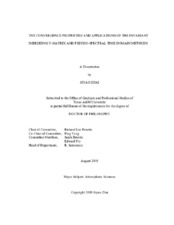| dc.description.abstract | This study focuses on investigating and improving the convergence of two numerical schemes for electromagnetic single scattering simulations: The pseudospectral time domain (PSTD) method and the invariant-imbedding T-matrix (II-TM) method. The single scattering properties (phase matrix, extinction, scattering cross section, etc.) can be obtained with these two methods for non-spherical and inhomogeneous particles. The single scattering properties are vital input for radiative transfer simulations of the atmosphere and oceans and are also used in retrievals for interpreting satellite observations of the atmosphere and surface. PSTD and II-TM are numerically exact methods because they solve Maxwell’s Equations. Given the proper choice of model parameters, their model outputs could be made as close as possible to the real solution. In this study, we study their convergence behaviors to make sure that they actually converge to the right solution. Specifically, for PSTD, we study the electromagnetic near field in its computational domain to see how the near field decays to zero. This is important since it determines how long we should integrate the discretized Maxwell’s equation in time domain. For the II-TM method, we study the Gaussian quadrature employed to compute the surface integrations. In the version of II-TM for hexagonal columns, we modify the original quadrature scheme to avoid quadrature over discontinuities. We also implement a new node and weight generating method into II-TM. These two improvements greatly accelerated II-TM method for hexagonal columns and spheroids.
An application of II-TM and a physical geometric optics method (PGOM) is presented. The application is to compute and compile a dataset intended for marine hydrosols. A hexahedral ensemble is used to simulate the complicated particle geometry. The size and refractive indices included in the dataset cover most natural marine hydrosols. We compare the single and bulk scattering properties of our hexahedra dataset with those obtained with the Lorenz-Mie method and discover major differences in the shape of the volume scattering function. | en |


